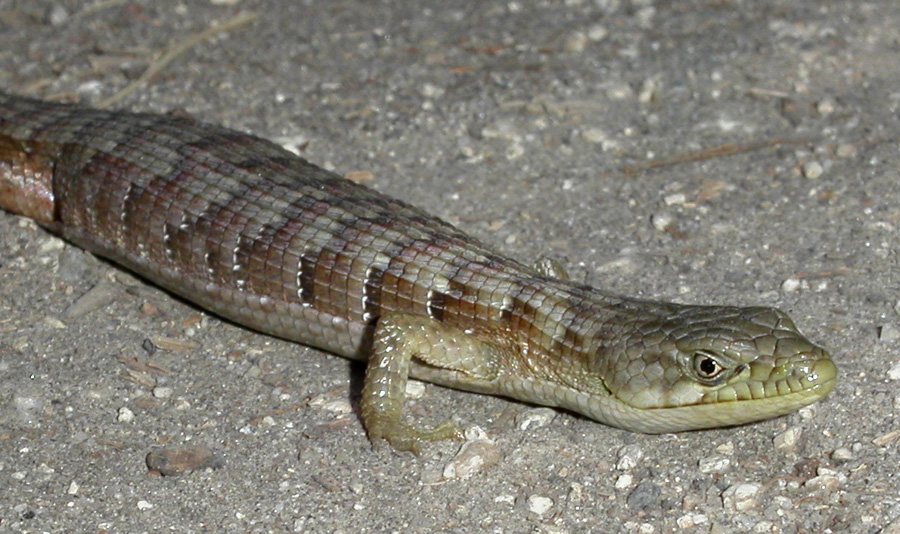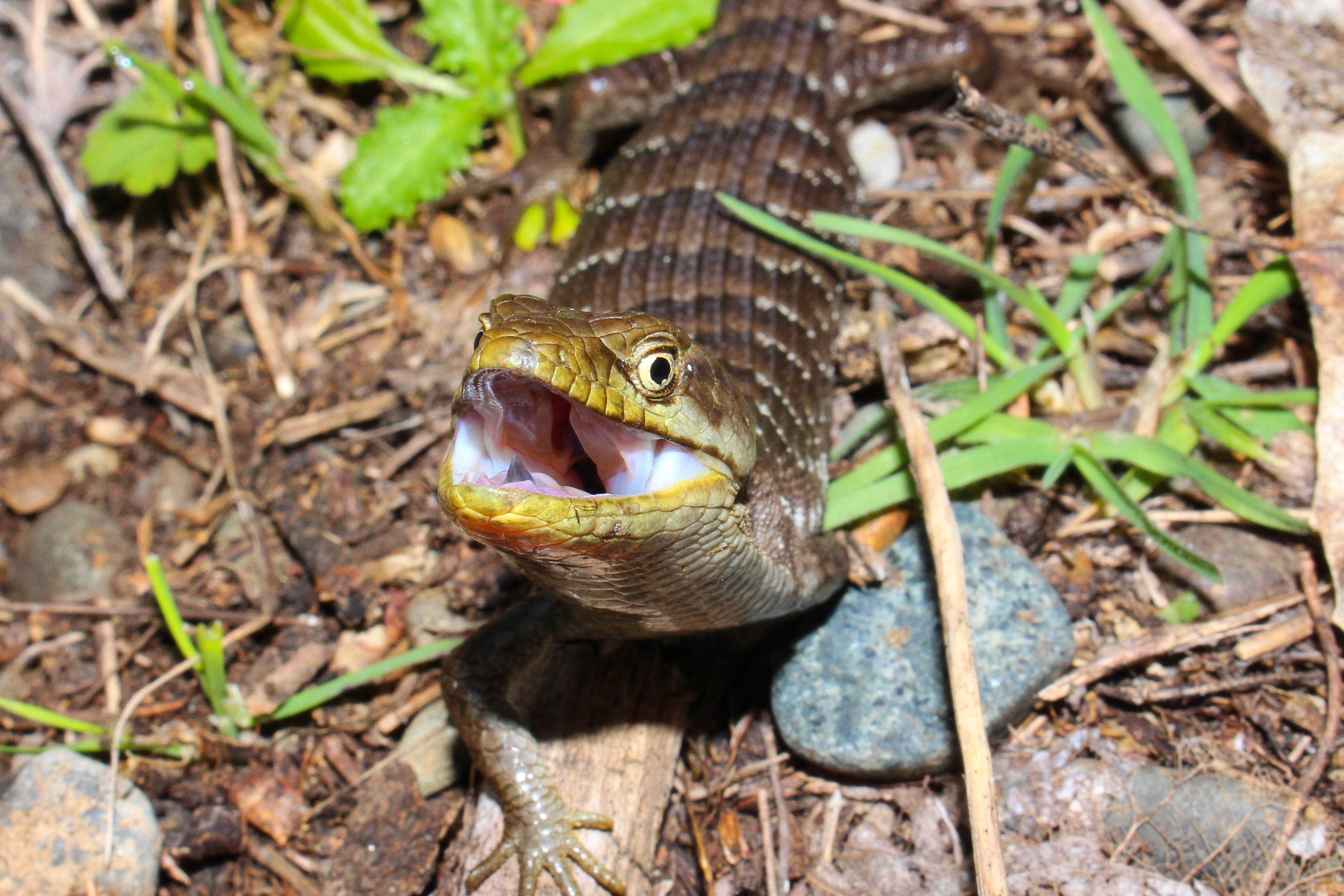Elgaria Multicarinata on:
[Wikipedia]
[Google]
[Amazon]
The southern alligator lizard (''Elgaria multicarinata'') is a common
 The southern alligator lizard measures from in snout-to-vent length (SVL). Including tail, it can reach a foot in length (30 cm). Stebbins Robert C. (2003). ''A Field Guide to Western Reptiles and Amphibians, Third Edition''. The Peterson Field Guide Series ®. Boston and New York: Houghton Mifflin. xiii + 533 pp. . (''Elgaria multicarinata'', pp. 331–332 + Plate 41 + Map 124). It has a round thick body with small legs and a long somewhat
The southern alligator lizard measures from in snout-to-vent length (SVL). Including tail, it can reach a foot in length (30 cm). Stebbins Robert C. (2003). ''A Field Guide to Western Reptiles and Amphibians, Third Edition''. The Peterson Field Guide Series ®. Boston and New York: Houghton Mifflin. xiii + 533 pp. . (''Elgaria multicarinata'', pp. 331–332 + Plate 41 + Map 124). It has a round thick body with small legs and a long somewhat
 The southern alligator lizard frequently can be found near human habitation, and is often seen foraging in the mornings and evenings. It is often found in or around suburban yards and garages. ''E. multicarinata'' is notable for its vicious self-defense, and will bite and defecate if handled.
Mating occurs in spring, typically from April to May, though in warmer regions this species will breed year-round. Eggs are usually laid between May and June and hatch during late summer and early fall. Females lay two clutches of eggs per year, often in decaying wood or plant matter to keep them warm. Females will guard the eggs until they hatch.
The southern alligator lizard frequently can be found near human habitation, and is often seen foraging in the mornings and evenings. It is often found in or around suburban yards and garages. ''E. multicarinata'' is notable for its vicious self-defense, and will bite and defecate if handled.
Mating occurs in spring, typically from April to May, though in warmer regions this species will breed year-round. Eggs are usually laid between May and June and hatch during late summer and early fall. Females lay two clutches of eggs per year, often in decaying wood or plant matter to keep them warm. Females will guard the eggs until they hatch.
Western Ecological Research Center: "''Elgaria multicarinatus'' ", the southern alligator lizard
species
A species () is often defined as the largest group of organisms in which any two individuals of the appropriate sexes or mating types can produce fertile offspring, typically by sexual reproduction. It is the basic unit of Taxonomy (biology), ...
of lizard
Lizard is the common name used for all Squamata, squamate reptiles other than snakes (and to a lesser extent amphisbaenians), encompassing over 7,000 species, ranging across all continents except Antarctica, as well as most Island#Oceanic isla ...
in the family
Family (from ) is a Social group, group of people related either by consanguinity (by recognized birth) or Affinity (law), affinity (by marriage or other relationship). It forms the basis for social order. Ideally, families offer predictabili ...
Anguidae
Anguidae refers to a large and diverse family of lizards native to the Northern Hemisphere. It contains 9 genera and 89 extant species. Common characteristics of this group include a reduced supratemporal arch, striations on the medial faces of t ...
. The species is native to the Pacific coast of North America
North America is a continent in the Northern Hemisphere, Northern and Western Hemisphere, Western hemispheres. North America is bordered to the north by the Arctic Ocean, to the east by the Atlantic Ocean, to the southeast by South Ameri ...
. It ranges from Baja California to the state of Washington and lives in a variety of habitats including grasslands, chaparral, forests, and even urban areas. In dry climates, it is likely to be found in moist areas or near streams. There are five recognized subspecies
In Taxonomy (biology), biological classification, subspecies (: subspecies) is a rank below species, used for populations that live in different areas and vary in size, shape, or other physical characteristics (Morphology (biology), morpholog ...
.
Subspecies
The following five subspecies are recognized as being valid, including thenominotypical subspecies
In biological classification, subspecies (: subspecies) is a rank below species, used for populations that live in different areas and vary in size, shape, or other physical characteristics ( morphology), but that can successfully interbreed. ...
.
*''Elgaria multicarinata ignava''
*''Elgaria multicarinata multicarinata''
*''Elgaria multicarinata nana''
*''Elgaria multicarinata scincicauda''
*''Elgaria multicarinata webbii''
Taxonomy and etymology
The generic name ''Elgaria'' is possibly named for an "Elgar" or a pun on "alligator." Thespecific name Specific name may refer to:
* in Database management systems, a system-assigned name that is unique within a particular database
In taxonomy, either of these two meanings, each with its own set of rules:
* Specific name (botany), the two-part (bino ...
''multicarinata'' refers to the keeled scales characteristic of this species. The common name "alligator lizard" is a reference to the fact that the back and belly scales of these lizards are reinforced by bone, as they are in alligators.
The subspecific name ''webbii'' is in honor of Thomas Hopkins Webb (1801–1866) who was Secretary of the United States and Mexican Boundary Survey
The United States and Mexican Boundary Survey was a Surveying, land survey that took play from 1848 to 1855 to determine the Mexico–United States border as defined in the Treaty of Guadalupe Hidalgo, the treaty that ended the Mexican–American ...
(1848–1855). The subspecific name ''scincicauda'' means "skink tail".
Description
 The southern alligator lizard measures from in snout-to-vent length (SVL). Including tail, it can reach a foot in length (30 cm). Stebbins Robert C. (2003). ''A Field Guide to Western Reptiles and Amphibians, Third Edition''. The Peterson Field Guide Series ®. Boston and New York: Houghton Mifflin. xiii + 533 pp. . (''Elgaria multicarinata'', pp. 331–332 + Plate 41 + Map 124). It has a round thick body with small legs and a long somewhat
The southern alligator lizard measures from in snout-to-vent length (SVL). Including tail, it can reach a foot in length (30 cm). Stebbins Robert C. (2003). ''A Field Guide to Western Reptiles and Amphibians, Third Edition''. The Peterson Field Guide Series ®. Boston and New York: Houghton Mifflin. xiii + 533 pp. . (''Elgaria multicarinata'', pp. 331–332 + Plate 41 + Map 124). It has a round thick body with small legs and a long somewhat prehensile
Prehensility is the quality of an appendage or organ that has adapted for grasping or holding. The word is derived from the Latin term ''prehendere'', meaning "to grasp". The ability to grasp is likely derived from a number of different origin ...
tail that can be twice as long as the lizard's body. Like many lizards, this species can drop its tail if attacked, possibly giving it a chance to flee. It lives on average 10 to 15 years, and survives well in captivity.
The color of this species is variable, and can be brown, gray, green, or yellowish above, often with red blotches on the middle of the back. Usually there are between 9 and 13 dark crossbands on the back, sides, and tail, with adjacent white spots. These crossbands can be pronounced or covered with reddish or yellowish color.
The scales of ''E. multicarinata'' are keeled on the back, sides, and legs. There are 14 rows of scales across the back at the middle of the body. A band of smaller granular scales separates the larger scales on the back and stomach, creating a fold along each side of the animal. These folds allow the body to expand to hold food or eggs.
Geographic range and habitat
The southern alligator lizard is native to the Pacific coast of North America, ranging from the state of Washington to Baja California. These lizards can be found across many diverse habitats, including grassland, open forest, chaparral, suburban and urban areas, and even into the desert along the Mojave River. This species is particularly common in foothill oak woodlands, and is often found hiding under rocks, logs, or other surface cover.Diet
''E. multicarinata'' eats smallarthropods
Arthropods ( ) are invertebrates in the phylum Arthropoda. They possess an arthropod exoskeleton, exoskeleton with a cuticle made of chitin, often Mineralization (biology), mineralised with calcium carbonate, a body with differentiated (Metam ...
, slugs, lizards, small mammals, and occasionally young birds and eggs.
The southern alligator lizard frequently eats western black widow spiders, and has demonstrated an immunity to the spider's potent venom.
Behavior and reproduction
 The southern alligator lizard frequently can be found near human habitation, and is often seen foraging in the mornings and evenings. It is often found in or around suburban yards and garages. ''E. multicarinata'' is notable for its vicious self-defense, and will bite and defecate if handled.
Mating occurs in spring, typically from April to May, though in warmer regions this species will breed year-round. Eggs are usually laid between May and June and hatch during late summer and early fall. Females lay two clutches of eggs per year, often in decaying wood or plant matter to keep them warm. Females will guard the eggs until they hatch.
The southern alligator lizard frequently can be found near human habitation, and is often seen foraging in the mornings and evenings. It is often found in or around suburban yards and garages. ''E. multicarinata'' is notable for its vicious self-defense, and will bite and defecate if handled.
Mating occurs in spring, typically from April to May, though in warmer regions this species will breed year-round. Eggs are usually laid between May and June and hatch during late summer and early fall. Females lay two clutches of eggs per year, often in decaying wood or plant matter to keep them warm. Females will guard the eggs until they hatch.
See also
* Northern alligator lizardReferences
External links
Western Ecological Research Center: "''Elgaria multicarinatus'' ", the southern alligator lizard
Further reading
* Behler, John L.; King, F. Wayne (1979). ''The Audubon Society Field Guide to North American Reptiles and Amphibians''. New York: Alfred A. Knopf. 743 pp. . (''Gerrhonotus multicarinatus'', pp. 542 + Plates 445, 449). * Blainville, H.D. de (1835). "''Description de quelques espèces de reptiles de la Californie précédée de l'analyse d'un système général d'herpétologie et amphibiologie'' ". ''Nouvelles Annales du Muséum D'Histoire Naturelle'' 4: 233–296. ("''Cordylus (Gerrhonotus) multi-carinatus'' ", new species, p. 289 + Plate XXV, figures 2, 2A, 2B, 2C). (in French). * Smith, Hobart M.; Brodie, Edmund D. Jr. (1982). ''Reptiles of North America: A Guide to Field Identification''. New York: Golden Press. 240 pp. (paperback), 0-307-47009-1 (hardcover). (''Elgaria multicarinata'', pp. 88–89). {{Taxonbar, from=Q2096735 Elgaria Reptiles of Mexico Reptiles of the United States Reptiles described in 1835 Taxa named by Henri Marie Ducrotay de Blainville